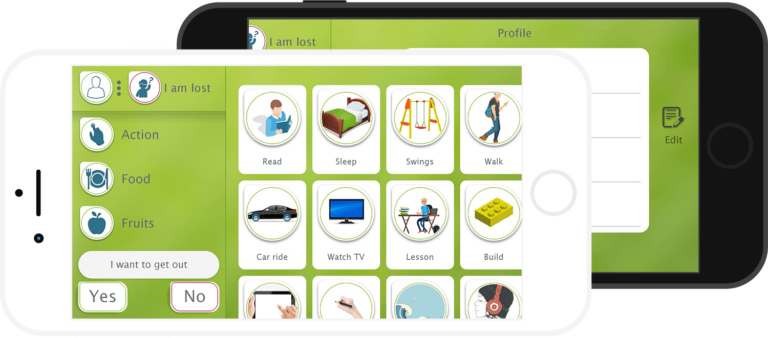The idea of the application is the result of a long search for a communication tool to assist a non- verbal boy with autism, Andreas. The particular child is hyperactive and all the tools found by parents until now for persons with autism require typing and multiple choice of sentence construction. Using such tool requires considerable training that might be impossible in certain cases and counter effective time wise when a quick expression of a need such as asking for water or the way out. The latter, the possibility to quickly escape from a loud or distracting place, is a basic need for people with autism for the avoidance of a possible tantrum. Furthermore, the particular boy is of Ukrainian and Greek origin and most of the existing tools, even with the drawbacks mentioned above, are in English and other languages he does not use. The need arose to design an efficient, easily understandable, and fast application that would help him communicate.
The above limitations gave birth to an idea for a unique tool. It allows fast communication directly with the use of phrases. Once the message is passed without any delay or hesitation, responding to it becomes easier. Thus, communication conforms and becomes closer to our normal speedy way of communicating on a day to day basis. It was primarily customized for Andreas and successfully tested in Greek on Andreas. The generalized versions in two languages followed. The more tests and improvements made, the more opportunities were opening. The next intended steps are recordings in other languages. Due to the various specific needs of different people with autism professional versions have also been created.
The idea of the application is the result of a long search for a communication tool to assist a non- verbal boy with autism, Andreas. The particular child is hyperactive and all the tools found by parents until now for persons with autism require typing and multiple choice of sentence construction. Using such tool requires considerable training that might be impossible in certain cases and counter effective time wise when a quick expression of a need such as asking for water or the way out. The latter, the possibility to quickly escape from a loud or distracting place, is a basic need for people with autism for the avoidance of a possible tantrum. Furthermore, the particular boy is of Ukrainian and Greek origin and most of the existing tools, even with the drawbacks mentioned above, are in English and other languages he does not use. The need arose to design an efficient, easily understandable, and fast application that would help him communicate.
The above limitations gave birth to an idea for a unique tool. It allows fast communication directly with the use of phrases. Once the message is passed without any delay or hesitation, responding to it becomes easier. Thus, communication conforms and becomes closer to our normal speedy way of communicating on a day to day basis. It was primarily customized for Andreas and successfully tested in Greek on Andreas. The generalized versions in two languages followed. The more tests and improvements made, the more opportunities were opening. The next intended steps are recordings in other languages. Due to the various specific needs of different people with autism professional versions have also been created.
The idea of the application is the result of a long search for a communication tool to assist a non- verbal boy with autism, Andreas. The particular child is hyperactive and all the tools found by parents until now for persons with autism require typing and multiple choice of sentence construction. Using such tool requires considerable training that might be impossible in certain cases and counter effective time wise when a quick expression of a need such as asking for water or the way out. The latter, the possibility to quickly escape from a loud or distracting place, is a basic need for people with autism for the avoidance of a possible tantrum. Furthermore, the particular boy is of Ukrainian and Greek origin and most of the existing tools, even with the drawbacks mentioned above, are in English and other languages he does not use. The need arose to design an efficient, easily understandable, and fast application that would help him communicate.
The above limitations gave birth to an idea for a unique tool. It allows fast communication directly with the use of phrases. Once the message is passed without any delay or hesitation, responding to it becomes easier. Thus, communication conforms and becomes closer to our normal speedy way of communicating on a day to day basis. It was primarily customized for Andreas and successfully tested in Greek on Andreas. The generalized versions in two languages followed. The more tests and improvements made, the more opportunities were opening. The next intended steps are recordings in other languages. Due to the various specific needs of different people with autism professional versions have also been created.


